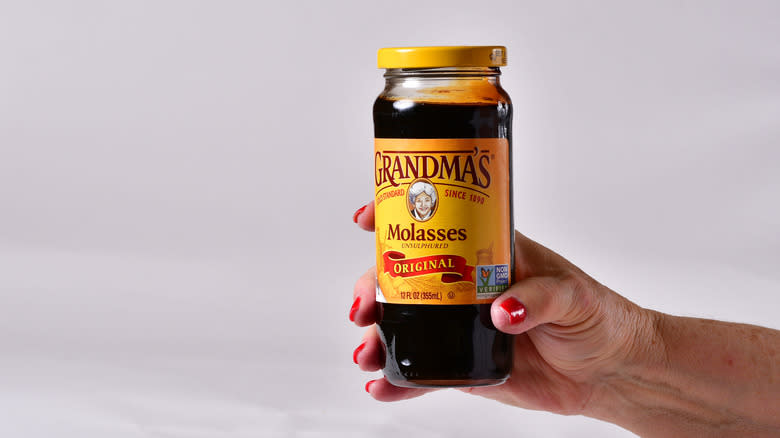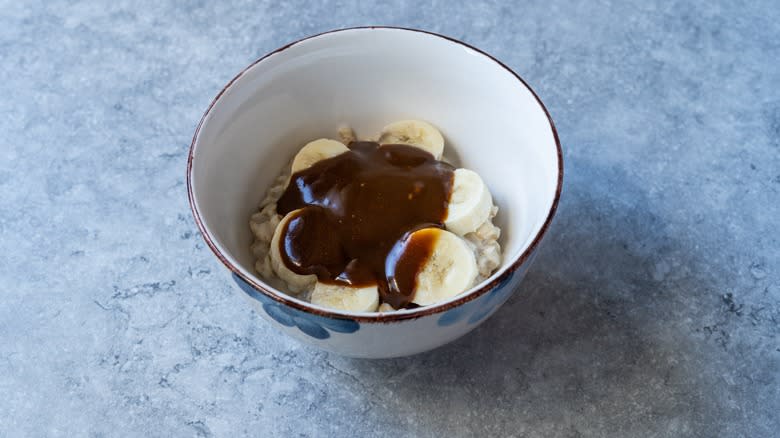Unsulphured Vs Sulphured Molasses: What's The Difference?

Sometimes, even the most essential pantry staples can take on complex forms. Consider sugar: as a sweet, ubiquitous condiment, it seems relatively straightforward in theory. Yet there are well over a dozen sugar types, which vary in both flavor and consistency. And when it comes to your liquid sweet needs, there's the dependable brown and sticky molasses.
It's the caramel-tinged flavor that's so common in southern and Caribbean cooking, used in everything from barbecue sauce to baked goods and even a plate of beans. Even the vast majority of rums are made from the product, employing this sugary byproduct to kickstart fermentation.
It's a clever use for what started as a leftover. After all, the sticky stuff is the remnant when raw sugar cane or sugar beet juice is boiled down to form crystallized sugar. Nowadays, the product is well established, with three different types of molasses that range in flavor and color. And you may have noticed another distinction: unsulphured versus sulphured. It's a slight deviation in processing, with the sulphur added to the young sugar cane for preservation. Yet the addition results in a flavor that's very palpably different.
Read more: 25 Chocolate Brands, Ranked Worst To Best
What Is Unsulphured Molasses?

Unsulphered molasses is the most common type of the syrup, accounting for most jars found on the shelves. It's usually made from ripe sugar cane, although it can also be crafted with sugar beets. Since the constituent sugar juice has reached full maturation, it's more stable once it's boiled down into a syrup. As a result, it doesn't require the sulphur preservative, hence the name.
Without the additive, this product has a lighter quality and more natural character. It can still encompass all three styles -- dark, light, or blackstrap -- so it's not tied to a specific molasses flavor. While most brands will note unsulphered on their jars, it can sometimes be easy to miss. This can make it tricky to distinguish sugar cane molasses from other products, like the subtly different flavor of sorghum or the more distinct pomegranate molasses. So, when buying in a pinch, make sure to double-check the base ingredient to obtain the desired syrupy notes.
What Is Sulphured Molasses?

The other type of molasses processing employs sulphur dioxide as a preservative. The chemical is added to young sugar cane in order to make the harvested plant more stable. This aids in storage until molasses production begins. Plus, the sulphur dioxide also amplifies the flavor to more strongly resemble fully-grown sugar cane.
Unfortunately, this modification also imparts a chemical taste, which many consumers find unpalatable. Depending on the manufacturer, this note can have a lingering effect, so it can be hard to shake. However, no need to worry about any accompanying adverse health effects. The United States Food and Drug Administration notes that the chemical is safe for consumption. After all, it's also used for the preservation of dried fruit, and sulphur dioxide is an important addition to wine. It really all boils down to a matter of taste. So, if you happen to obtain a sulphured jar of molasses, feel free to employ it in recipes, nevertheless.
Reach For Unsulphured Molasses For A More Natural Flavor

If you're staring at both varieties on the shelf, there are no real reasons to reach for the sulphured molasses. The pure variety has that delicate and delicious molasses flavor that makes the syrup a kitchen favorite. As a result, it's the preferable ingredient in all applications, especially where the molasses is more prominent. Unsulphered molasses is the better candidate for the sweet addition your morning oatmeal needs or as the star of molasses gingersnap cookies.
Sulphured molasses is oftentimes less predominantly sweet, but at the cost of losing complexity. So, if you do have a jar on hand, save it for savory applications. It can be an addition to sweeten and thicken a store-bought barbecue sauce or an ingredient in a particularly bold marinade. Make sure to pair it with other aromatic ingredients -- perhaps something salty or with a bit of spice -- to avoid making the chemical notes a noticeable element in your dish. With such considerations, you'll be able to enjoy your molasses stress-free, adapting to whether or not it contains sulphur.
Read the original article on Tasting Table.


